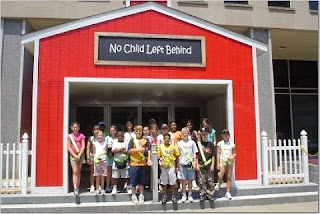How To Tuesday -NCLB My Way

No Child Left Behind:
Counting Systems that Work
and Don't Work!
Bueller? Bueller?
This is the chaotic scene within the bus, outside the bus, in noisy and crowded areas, as well as in various buildings all during the ETP. By the time we have finished counting, nearly 15 minutes have passed. And this happens seven or eight times a day. Nearly two hours can be wasted each day because of a poor counting system!
This is when I need to, 'count to ten', several times.
As a tourguide, I have been frustrated at the waste of precious time and very often it causes a great deal of stress to make an appointment, especially in places where five minutes can be the difference between getting into a site right away or standing in a long line created by the six busloads of students who got right in front of you. Several times during this process, the bus is made to go around the block, or several blocks, because it cannot 'stand' someplace for more than five minutes. More wasted time.
No Child Left Behind has always been my motto; I don't leave students behind. (Well, in twenty-five years and over 17,000 students, I've missed two, but realized this quickly.) There are some good counting systems, systems which allow a teacher or guide to know exactly who is there, and more importantly, who is not there, immediately.
Here is one of my favorite systems:
Firstly, the students should be broken up into interest groups in advance of the trip. By interest groups, I am referring to groups of four or more students who are friends, room together, or at least those who would naturally eat together, shop together, or stay together at a venue. It's important to create concrete 'buddy groups'.
Each of these groups should be assigned either a number or they can choose a group name i.e. Patriots, Blue Tigers, Flamingoes etc. If there are enough parents, one should be assigned to each group, if not, one of the students within the group should be assigned as the 'captain' of the group. No child should be by himself or herself at any time or place. There should be at least three in a buddy group.
When the large group assembles, the teacher in charge or the tour guide needs to call out or indicate in some way (I have hand signals), to gather and count. In fact, I have a rule that wherever we meet, they all need to stand with their respective groups even before we start to count. The teacher calls out the first group. (or Flamingoes) and the parent or 'captain' relays whether the whole group is present or not, and more importantly, who is missing. Occasionally, I simply have the complete groups 'check in' before boarding the bus.
I have been able to complete an accurate count of a a group of 50 within a minute with this system!
This style of counting can be very effective for many ways because it keeps the interest groups together and responsible for one another.
These groups can also stay together for various activities, games, or good-natured competition. (Think in terms of the 'house' system at Hogwarts.)
It's important to find a convenient place for this count. A meeting place should be slightly away from a main entrance and giving an exact location with a landmark is best. I've been known to say, "Meet at the sixteenth brick from the door on the left side of the entrance at 4:30 PM and please be ready in your counting groups. I have them either write that down and/or repeat it three times. They have fun counting the bricks.
When loading a bus, only those groups that are complete, should go aboard, unless it is raining etc. (Your bus/classroom management skills come in handy here, to make sure all are seated and there is nothing in the aisle.
When all are on board, it should only take about thirty seconds to do a head count.
Never do a 'head count' on a bus from the front to the back. Always do it from the back to the front, so no one can get off the bus again (to find a lost article or throw out a can of soda) without you being aware of it.
Instead of counting each head on a bus, one should count by 'twos' which is each bank of seats. it simply goes faster. I have a strange system that works for me: I count by two's and if there is a bank of seats with only one student , I put my thumb up, and continue the count by two's, and when there is another bank of seats with another single student, I then take away the thumb and add, 'two'. If there is an odd number of students, I end by adding the single student (represented by my thumb) to the count. I guess you have to be there to see it.
Is everybody here?
This is a question that should never be asked. (Missing people cannot reply to this!)
The Educational Tour Marm















2 comments:
I have a roster of everyone assigned to my bus and check them off as they board. I've found this is usually faster than leaving it up to the teachers. I hate driving around the block!
Hi!
Thanks for visiting!
Yep, I've been around the block, too!
Most of my good bus drivers (motorcoach operators) do count the kids when it is convenient; But most do not.
One cannot count enough times.
However, there are times when we have to count between museum visits and we are not going to board the bus. It is essential to have buddy-groups looking after one another.
Post a Comment